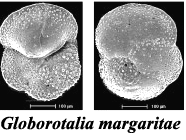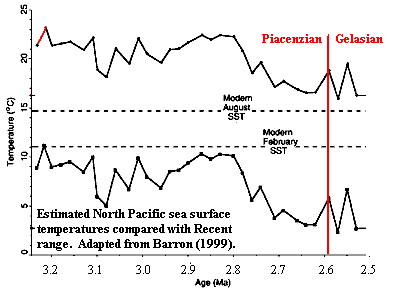The Piacenzian
The Piacenzian Age of the Pliocene Epoch: 3.60 to 2.59 million years ago
|
Pliocene
Zanclean
Piacenzian
Gelasian
Pleistocene
|
 The Piacenzian Age is the first half of the Late Pliocene, a sub-epoch that we do not cover as a separate unit. Its base is defined by the bottom of magnetic polarity zone C2An (called the "Gauss Normal" chron) and the extinction of the forams Globorotalia margaritae and Pulleniatina primalis at Punta Piccola, in Sicily.
The Piacenzian Age is the first half of the Late Pliocene, a sub-epoch that we do not cover as a separate unit. Its base is defined by the bottom of magnetic polarity zone C2An (called the "Gauss Normal" chron) and the extinction of the forams Globorotalia margaritae and Pulleniatina primalis at Punta Piccola, in Sicily.
The Piacenzian is also referred to as the "Middle Pliocene" by ICS. This is unnecessarily confusing, since this period has, under various names, always been regarded as Late Pliocene. However, it may also be necessary. The Gelasian Age was carved out of the Piacenzian by ICS quite recently (in 1996). References to the "Piacenzian" in the literature, even in the last few years, refer to the entire Late Pliocene, i.e. the Piacenzian + Gelasian. See, e.g., McKinney & Taylor (2001).
While only one million years long, the Piacenzian was an eventful age, particularly for our own ancestors. The Piacenzian saw the run-up to the first Ice Age and the formation of the land bridge between North and South America. This was also the age of "Lucy," Australopithecus afarensis, and the radiation of robust and gracile hominids which produced the genus Homo. All over the globe, species turnover was accelerated, as high latitude temperatures dropped, the ice sheets gathered, and ocean circulation patterns approached their present form.
Image: Globorotalia from Li et al. (2003).
ATW040925. Text public domain. No rights reserved.
Life in the Piacenzian
 In Europe, mammoth, tapirs, and the little bear, Ursus minimus, died out along with rodents, like Mimomys, which were adapted to temperate or subtropical climates and open woodlands. They were replaced in the Gelasian by species more suited for colder and more open environments. A similar change is seen throughout the Northern Hemisphere in what is referred to as the "Elephant-Equus Event," named for the conspicuous change from Piacenzian elephants to Gelasian horses as the dominant open-country ungulate. Azzaroli (1995). This event is reflected by rapid changes in pollen, foraminifera, and mollusk indicators from the same time. However, these indicators also suggest that a number of shorter "cold spells" preceded the final temperature plunge at the end of the Piacenzian. Serrano et al. (1999). The same pattern occurred over most of the world, See, e.g., the graph from Barron 1999).
In Europe, mammoth, tapirs, and the little bear, Ursus minimus, died out along with rodents, like Mimomys, which were adapted to temperate or subtropical climates and open woodlands. They were replaced in the Gelasian by species more suited for colder and more open environments. A similar change is seen throughout the Northern Hemisphere in what is referred to as the "Elephant-Equus Event," named for the conspicuous change from Piacenzian elephants to Gelasian horses as the dominant open-country ungulate. Azzaroli (1995). This event is reflected by rapid changes in pollen, foraminifera, and mollusk indicators from the same time. However, these indicators also suggest that a number of shorter "cold spells" preceded the final temperature plunge at the end of the Piacenzian. Serrano et al. (1999). The same pattern occurred over most of the world, See, e.g., the graph from Barron 1999).
This drying trend was even more pronounced in East Africa, where the global aridification was augmented by regional uplifts (caused by the cracks which appeared in the African craton) casting rain shadows over parts of the area. Partridge et al. (1995). On the other hand, a detailed study of the fauna at Omo fails to demonstrate any large turnover connected with the Piacenzian, despite rapid evolution of bovids in other parts of the continent. Wesselman (1995).
Faunal changes in Americas were marked by the Great American Interchange related to the formation of the interamerican land bridge. The formation of the Isthmus of Panama allowed the long-isolated North and South American vertebrates to mix. The land bridge allowed the armadillo, porcupine, opossum, and ground sloths to colonize the north, as well as the unique South American notoungulates. The sloths and, to a lesser extent, the notoungulates, prospered, but are now extinct. The others were initially restricted to the most southerly parts of North America but are now expanding their ranges. The Northern immigrants to South America included the rodents, Carnivora (bears, cats, dogs, etc.), llamas and horses, bovids (particularly deer), and the tapirs and elephants.
Our understanding of the Interchange has changed greatly in recent years. It was originally viewed as a conquest of the South by the North. It now appears to have been a more even-handed and less catastrophic event. Many of the extinctions originally attributed to the Interchange, particularly the unique endemic South American ungulates, occurred either earlier, in the Late Miocene, or later, in the Pleistocene.
ATW040929. Text public domain. No rights reserved.
Base of Piacenzian Stratotype: stratigraphic definition and markers. The full description and rationale can be found in Castradori, D, D Rio, FJ Hilgen & LJ Lourens (1998), The global standard stratotype-section and point (GSSP) of the Piacenzian Stage (Middle Pliocene). Episodes21: 88-93. Better versions of some of the images can be found at base Piacenzian.
last modified ATW040929, edited RFVS111024
checked ATW031018
 The Piacenzian Age is the first half of the Late Pliocene, a sub-epoch that we do not cover as a separate unit. Its base is defined by the bottom of magnetic polarity zone C2An (called the "Gauss Normal" chron) and the extinction of the forams Globorotalia margaritae and Pulleniatina primalis at Punta Piccola, in Sicily.
The Piacenzian Age is the first half of the Late Pliocene, a sub-epoch that we do not cover as a separate unit. Its base is defined by the bottom of magnetic polarity zone C2An (called the "Gauss Normal" chron) and the extinction of the forams Globorotalia margaritae and Pulleniatina primalis at Punta Piccola, in Sicily.
